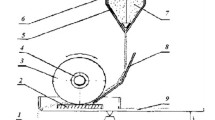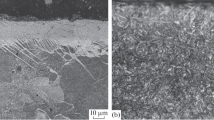The paper studies mechanisms of increasing the adhesive wear resistance of the copper specimens after the bombardment by the nitrogen ions, which are coupled with a counterbody and operate in inert atmosphere. It is shown that the increase in the wear resistance is complex and connected with such mechanisms as solid solution hardening, size reduction of copper grains, fine CuN3 particle formation, dislocation density growth, and internal microscopic stress generation in the specimen surface layer. As compared to the initial state of the copper specimen, the wear resistance and microhardness of the ion-modified specimen increase approximately by 4 and 2.6 times, respectively, at the ion irradiation fluence of 9·1017 cm2. Further increase in the fluence leads to the reduction in the wear resistance and microhardness due to the pore growth in the surface layer caused by the nitrogen ion implantation.
Similar content being viewed by others
References
F. F. Komarov, Ion Implantation in Metals [in Russian], Metallurgiya, Moscow (1990).
J. C. Szcancoski, C. E. Foerstera, C. Serbena, et al., Surf. Coat. Technol., 201, 1488–1494 (2006).
F. Abdi and H. Savaloni, Trans. Nonferrous Met. Soc. China, 27, No. 3, 701–710 (2017).
M. V. Fedorischeva, M. P. Kalashnikov, V. P. Sergeev, and V. V. Neufeld, Bull. Russ. Acad. Sci. Phys., 78, No. 8, 710–712 (2014).
K. K. Shih, Wear, 105, No. 4, 341–347 (1985).
A. H. Sari, M. K. Salem, and A. Shoorche, J. Fusion Energy, 30, 323–327 (2011).
S. M. Myers, J. A. Knapp, D. M. Follstaedt, et al., Surf. Coat. Technol., 103–104, 287–292 (1998).
S. B. Wang, P. R. Zhu, and W. J. Wang, Surf. Coat. Technol., 123, 173–176 (2000).
W. Oliver and G. Pharr, J. Mater. Res., 7, No. 6, 1564–1583 (1992).
S. A. Saltykov, Stereometric Metallography [in Russian], Metallurgiya, Moscow (1970).
P. B. Hirsch, A. Howie, R. B. Nicholson, et al., Electron Microscopy of Thin Crystals [Russian translation], Mir, Moscow (1968).
E. O. Hall, Proc. Phys. Soc. Lond., 64, 747–753 (1951).
M. L. Bernshtein and V. A. Zaimovskii, Structure and Mechanical Properties of Metals [in Russian], Metallurgiya, Moscow (1970).
V. P. Sergeev, A. R. Sungatulin, M. P. Kalashnikov, et al., Adv. Mater. Res., 1085, 201–204 (2015).
J. Friedel, Dislocations [Russian translation], Mir, Moscow (1967).
Author information
Authors and Affiliations
Corresponding author
Additional information
Translated from Izvestiya Vysshikh Uchebnykh Zavedenii, Fizika, No. 9, pp. 72–79, September, 2020.
Rights and permissions
About this article
Cite this article
Sergeev, V.P., Kalashnikov, M.P., Sungatulin, A.R. et al. Adhesive Wear of Copper Friction Pair in Inert Atmosphere Reduced by Nitrogen Ion Implantation. Russ Phys J 63, 1530–1537 (2021). https://doi.org/10.1007/s11182-021-02202-y
Received:
Published:
Issue Date:
DOI: https://doi.org/10.1007/s11182-021-02202-y




